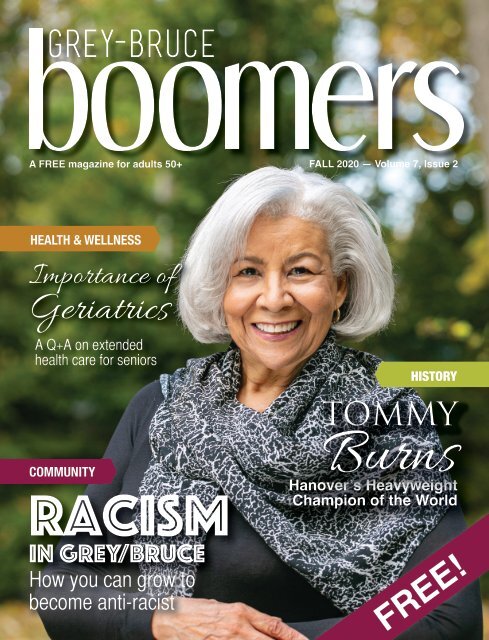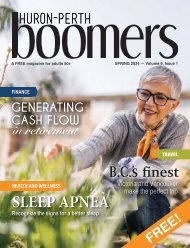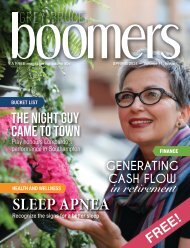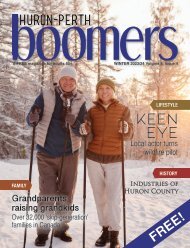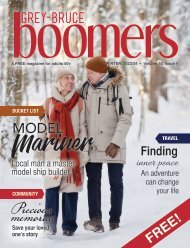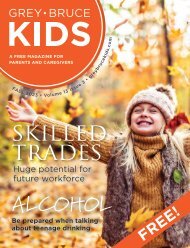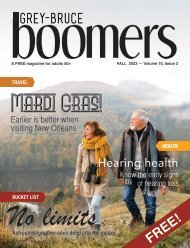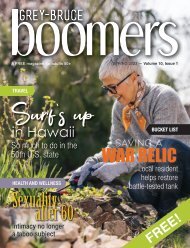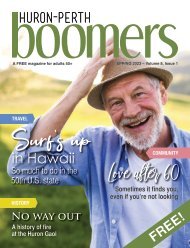Grey-Bruce Boomers Fall 2020
You also want an ePaper? Increase the reach of your titles
YUMPU automatically turns print PDFs into web optimized ePapers that Google loves.
A FREE magazine for adults 50+<br />
FALL <strong>2020</strong> — Volume 7, Issue 2<br />
HEALTH & WELLNESS<br />
Importance of<br />
Geriatrics<br />
A Q+A on extended<br />
health care for seniors<br />
HISTORY<br />
COMMUNITY<br />
Racism<br />
in <strong>Grey</strong>/<strong>Bruce</strong><br />
How you can grow to<br />
become anti-racist<br />
TOMMY<br />
Burns<br />
Hanover’s Heavyweight<br />
Champion of the World<br />
FREE!
SOCIAL PURPOSE ORGANIZATIONS<br />
ARE SUPPORTING OUR COMMUNITY<br />
We all want communies where<br />
everyone can belong and thrive.<br />
Your Foundaon is parcipang in<br />
the Investment Readiness Program<br />
to support new and innovave ways<br />
of geng us there. It is designed to<br />
help social purpose organizaons<br />
explore, grow and flourish across<br />
Canada, contribung to solving<br />
pressing social, cultural and<br />
environmental challenges.<br />
COMMUNITY<br />
FOUNDATION<br />
GREY BRUCE<br />
We’re here for good.<br />
P.O. Box 81 Owen Sound ON N4K 5P1 519.371.7203<br />
2<br />
2<br />
The Next25 Fund will give the Foundaon the<br />
latude to grant strategically to the greatest<br />
community need based on local knowledge for local<br />
impact. Consider a gi to your community with a<br />
donaon to the Next25 Fund.<br />
www.communityfoundaongreybruce.com
FALL <strong>2020</strong>: THE<br />
UNCERTAINTY<br />
SURROUNDING<br />
UNIVERSITY &<br />
COLLEGE<br />
1101 2nd Avenue East, Suite 208<br />
Owen Sound, ON N4K 2J1<br />
alex.ruff@parl.gc.ca<br />
alexruffmp.ca • 519-371-1059<br />
READ MORE<br />
TFSA VS RRSP -<br />
DETERMINING THE BEST APPROACH<br />
A free magazine for adults 50+<br />
Get the only magazine for <strong>Boomers</strong> in <strong>Grey</strong> & <strong>Bruce</strong>!<br />
Local information by local writers | Affordable advertising<br />
10,000 copies published 4 times a year<br />
To write, advertise or distribute contact Amy Irwin at<br />
519-524-0101 or email amy@greybruceboomers.com.<br />
www.greybruceboomers.com<br />
5 FINANCIAL<br />
TIPS FOR<br />
RENOVATING<br />
YOUR<br />
RETIREMENT<br />
HOME<br />
READ MORE<br />
READ MORE<br />
Do you know a<br />
friend or loved one<br />
facing a health crisis?<br />
• Spread the task of caregiving among many people<br />
so that no one person is alone, overwhelmed or<br />
compromised<br />
Find these articles and more on<br />
www.mannerow.ca or<br />
Facebook.com/MicheleMannerowCFP<br />
Plan • Invest • Retire<br />
• Family, friends, relatives, neighbours, co-workers<br />
pool their talents to help<br />
• Makes caregiving a meaningful, loving experience<br />
replacing stress, fear and loneliness with teamwork,<br />
courage and friendship<br />
For information on this caregiving model contact:<br />
Share the Care Promoter located at the<br />
Alzheimer Society of <strong>Grey</strong>-<strong>Bruce</strong><br />
519-376-7230 or 1-800-265-9013<br />
Michele Mannerow CFP, R.F.P., CIM, FCSI, FMA<br />
Financial Advisor - Manulife Securities Incorporated<br />
Insurance Advisor - Manulife Securities Insurance Inc.<br />
167 - 10th Street West, Owen Sound, N4K 3R1<br />
Branch (519) 470-2250 Direct (519) 470-PLAN (7526)<br />
www.mannerow.ca | m.mannerow@manulifesecurities.ca<br />
FALL <strong>2020</strong> • 3
FROM THE PUBLISHER<br />
<strong>Fall</strong> is usually when we visit apple orchards, attend <strong>Fall</strong> Fairs, cover our outdoor<br />
plants in preparation for the first frost, get those last rounds of golf in, and even<br />
start planning where we’ll spend our winters, whether just for a couple of weeks or<br />
for months at a time.<br />
This year, obviously, looks a little different due to the upheaval to the norm caused<br />
by the COVID-19 pandemic. Now we’re preoccupied with buying facemasks,<br />
restocking hand sanitizer, talking to travel agents about cruise ship refunds, and<br />
watching the news south of the border with hopes our winter travel plans aren’t a<br />
long shot at best. Some of our readers may even be looking for a place to live when<br />
the weather turns cold, as more retirees don’t keep a winter home in <strong>Grey</strong>/<strong>Bruce</strong><br />
anymore, spending the coldest months in a condo or trailer down south, while<br />
living the cottage life locally during our beautiful summers.<br />
CONTENTS<br />
Biking Vietnam • 6<br />
Our Heavyweight Champ • 12<br />
Chronicling COVID-19 • 16<br />
Racism in Canada • 20<br />
Q+A on Geriatrics • 26<br />
Game Changer • 30<br />
Recipe • 32<br />
This isn’t exactly news, but COVID has changed almost every aspect of our lives,<br />
including here at <strong>Grey</strong>-<strong>Bruce</strong> <strong>Boomers</strong>. We still have the same great local content,<br />
resources and advertisers, but you won’t be able to pick up a copy at the dentist’s<br />
office, grocery store or pharmacy — instead you can read us anywhere and<br />
everywhere as we are again exclusively digital. Our user-friendly platform allows<br />
direct links to all websites, which makes it easy for you to learn more about what<br />
interests you and to visit our amazing local advertisers (who still need your support!).<br />
While we do hope to return to print soon, in the meantime please like our Facebook<br />
page and interact with and share our posts, subscribe to our online newsletter, and<br />
support the advertisers who were able to support us in these difficult times.<br />
We wish you and your family continued good health<br />
and hope you can enjoy what our area has at this<br />
most beautiful time of year — socially distanced, of<br />
course!<br />
Amy Irwin, Publisher<br />
<strong>Grey</strong>-<strong>Bruce</strong> <strong>Boomers</strong><br />
FALL <strong>2020</strong><br />
Publisher<br />
Amy Irwin<br />
amy@greybruceboomers.com<br />
Advertising Sales Manager<br />
Linda Thorn<br />
linda@greybruceboomers.com<br />
Magazine Design<br />
Becky Grebenjak<br />
<strong>Grey</strong>-<strong>Bruce</strong> <strong>Boomers</strong> welcomes<br />
your feedback.<br />
EMAIL<br />
amy@greybruceboomers.com<br />
PHONE 519-524-0101<br />
MAIL<br />
P.O. Box 287, Ripley, ON N0G 2R0<br />
<strong>Grey</strong>-<strong>Bruce</strong> <strong>Boomers</strong> is distributed for free in <strong>Grey</strong> and <strong>Bruce</strong><br />
counties, and is published each March, June, September, and<br />
December. Distribution of this publication does not constitute<br />
endorsement of information, products or services by <strong>Grey</strong>-<strong>Bruce</strong><br />
<strong>Boomers</strong>, its writers or advertisers. Viewpoints of contributors and<br />
advertisers are not necessarily those of the Publisher. <strong>Grey</strong>-<strong>Bruce</strong><br />
<strong>Boomers</strong> reserves the right to edit, reject or comment on all material<br />
and advertising contributed. No portion of <strong>Grey</strong>-<strong>Bruce</strong> <strong>Boomers</strong> may<br />
be reproduced without the written permission of the Publisher.
DISCOVER THE APARTMENTS AT HARBOUR HILL<br />
JUST RELEASED<br />
ONE AND TWO BEDROOM APARTMENTS<br />
104 Suncoast Drive East, Goderich • 519-440-0110
THE BUCKET LIST<br />
Pedaling<br />
passion<br />
A TWO-WHEEL TREK THROUGH VIETNAM BY DOUG ARCHER<br />
6 • GREYBRUCEBOOMERS.COM
y Doug Archer<br />
THE BUCKET LIST<br />
This past winter, Cathy and Derrick Alstein decided to<br />
skip their annual trip to Florida.<br />
It’s not that the Saugeen Shores couple got tired of<br />
sunshine and golf; they just had a different kind of winter<br />
getaway in mind.<br />
“It is something we had always wanted to do,” Cathy<br />
said. “So we figured we’d better do it while we still could.”<br />
So they did. The couple undertook a 15-day, 600-kilometre<br />
cycling adventure through Vietnam.<br />
The idea for the trip actually came to them on a hiking<br />
tour in New Zealand several years back. Their guide<br />
raved about spending his off-seasons biking in Vietnam,<br />
and that got them thinking.<br />
“We love taking trips where we get to see places and<br />
people up close and personal – and we’d never been<br />
to Southeast Asia,” Derrick said. “So a cycling trip to<br />
Vietnam seemed perfect.”<br />
Then when Saddle Skedaddle – a tour company they’d<br />
previously travelled with to Britain – promoted a bike<br />
excursion to Vietnam, the decision was made. They<br />
convinced a couple of their friends, Jayne Holt and Nina<br />
DiRisio, to join them, and booked the trip.<br />
Of course, biking 80 to 100 km a day, with innumerable<br />
mountain ascents, in sub-tropical heat, is not for the faint<br />
of heart. Although Cathy and Derrick keep themselves<br />
in shape, a little training was in order. So, in the months<br />
leading up to their journey, the couple took spin classes,<br />
rode stationary bikes, and went on cycling road trips. Still,<br />
Cathy worried about the uphill climbs.<br />
“Even though the tour company had a support mini-bus<br />
that travelled with the group, I didn’t want to be the one<br />
that had to climb on board it to get up the mountainsides,”<br />
she said.<br />
Consequently, Cathy, Jayne and Nina inquired about<br />
e-bikes – and Saddle Skedaddle came through, providing<br />
the trio with electric two-wheelers. Now nothing stood<br />
in their way. On Feb. 13, after 19 hours of flight time<br />
and a stopover in Taipei, Cathy, Derrick, and their travel<br />
buddies touched down in Ho Chi Minh City (Saigon),<br />
ready to meet the rest of their intrepid tour group and<br />
begin their cycling escapade.<br />
It was a great group of people. Four fellow Canadians,<br />
seven Brits, two Vietnamese tour guides, a driver for the<br />
support bus, and a bike mechanic all got along famously,<br />
from the welcoming drinks to the farewell dinner, Cathy<br />
said.<br />
Right after meeting the group, though, it was early to bed<br />
for an early rise. No kidding around on this tour. On the<br />
first morning – and virtually every one thereafter – the<br />
cyclists were up at sunrise, finished breakfast and pedaling<br />
their bikes by 8 a.m. As a concession, Day One was a<br />
“short” 40 km ride, meant to gently break in the cyclists.<br />
“But even that first day had a hill,” Derrick said. “And<br />
it was enough of a challenge that it separated the good<br />
FALL <strong>2020</strong> • 7
THE BUCKET LIST<br />
by Doug Archer<br />
cyclists in our group from… well, from me,” he laughed.<br />
As the days went on, the riding got tougher and longer.<br />
Most days they cycled 80 km; one day they pedaled into<br />
the triple digits. But oh, the things they saw!<br />
World heritage sites like Hoi An, an Asian trading port<br />
dating back 600 years and filled with canals, wooden<br />
temples, and the famous covered Japanese Bridge.<br />
Bustling cities like Saigon – the Pearl of the Orient – and<br />
Hanoi with its chaotic Old Quarter where the narrow<br />
streets are arranged by trade. Full moon lantern festivals;<br />
prehistoric looking stone temples; and coastlines gazing<br />
out onto raised islands and towering rock pinnacles.<br />
They rode alongside water-covered rice paddies, stopping<br />
to talk via their tour guides to the locals who farmed<br />
them, past roadside markets, and into tiny settlements<br />
that no tour bus could ever get to.<br />
As Cathy put it, “We travelled along dirt pathways that<br />
took us to villages where the local children would come<br />
running out to greet us because they were so excited to<br />
see westerners.”<br />
Then there were the animals. While the odd village dog<br />
gave chase, it was the water buffalo they had to watch for<br />
– and the cows.<br />
“Massive, horned water buffaloes were everywhere,”<br />
Derrick said. “On one rural path we literally had to ride<br />
through a herd of cows that was meandering along the<br />
same trail.”<br />
As good fortune would have it, even though Cathy and<br />
Derrick were in Vietnam in the back half of February and<br />
early March, COVID-19 was not an issue. In a country<br />
with over 95 million people, at the time of writing this<br />
piece, Vietnam’s total cases had yet to exceed 400 and<br />
they had zero deaths.<br />
“The Vietnamese jumped on the Coronavirus right<br />
away, closing down schools as well as their borders with<br />
China in January,” Derrick said. “Everyone wore masks<br />
and we had our temperatures taken countless times –<br />
at the airport, in the hotels, and you couldn’t go into a<br />
restaurant without passing the thermometer test.”<br />
While COVID-19 wasn’t one of them, there were a few<br />
8 • GREYBRUCEBOOMERS.COM
y Doug Archer<br />
THE BUCKET LIST<br />
challenges on the bike tour. The heat for one. Hot and<br />
humid, the temperature was often in the high-30s – and<br />
one day it hit 42 C!<br />
“One person in the group even fainted on the first day<br />
from the heat,” Derrick said.<br />
There was also the odd bit of traffic. While most of the<br />
cycling was along the Vietnamese coastline and through<br />
the countryside, Cathy said that, about halfway into the<br />
trip, they had to bike through a city called Dalat, at rush<br />
hour no less!<br />
“I’d never seen so many motorcycles, scooters and<br />
mopeds in my whole life,” she said. “All zooming and<br />
zigzagging around us as we tried to pedal along. It was<br />
barely controlled mayhem!”<br />
But it was the uphill rides that proved the biggest<br />
challenge. At least for Derrick.<br />
“One day we had to pedal 10 km straight up a<br />
mountainside in 30-plus temperatures! To make matters<br />
even more disheartening, partway up the mountain,<br />
Cathy, Jayne and Nina went sailing by me on their e-bikes,<br />
but I made it! I wasn’t about to suffer the shame of having<br />
to climb aboard the support bus and be driven to the top<br />
of the mountain.”<br />
To ensure they stayed hydrated and fueled for the long<br />
bike rides, the group stopped every two hours. Midmorning<br />
and afternoon they’d load up on water – spiked<br />
with lemon juice and electrolytes – accompanied by a<br />
fruit snack. But it was the delights of the region’s cuisine<br />
that they partook of at lunches and dinners that truly<br />
kept them pedalling.<br />
“We all got hooked on Pho,” Derrick admitted.<br />
Considered Vietnam’s national dish, Pho (pronounced<br />
‘Fa’) – Vietnamese noodle soup – consists of a piquant<br />
FALL <strong>2020</strong> • 9
THE BUCKET LIST<br />
only were we treated to magnificent meals, it gave us a<br />
real sense for the way families live and manage in rural<br />
Vietnam.”<br />
The beer wasn’t too bad, either. Cathy and Derrick<br />
couldn’t wait until the end of their daily rides to tip back<br />
a Saigon brew or two. “It went down easy,” declared<br />
Derrick, “which was a good thing, because the wine in<br />
Vietnam was terrible.”<br />
But according to Cathy, the very best thing about eating<br />
and drinking on the bicycle trip was that it was guilt free.<br />
“We were able to consume whatever we wanted – in<br />
whatever quantity we wanted – because we would just<br />
burn it off on the next day’s ride!”<br />
After two weeks in the saddle — with, miraculously, no<br />
saddle sores to speak of — they ended their cycling tour<br />
in Hanoi, the capital of Vietnam, located in the country’s<br />
north.<br />
“We were sad when it was over and having to say goodbye<br />
to our fellow cyclists and amazing tour guides,” Cathy<br />
said. “It was truly a wondrous experience – the trip was<br />
everything we thought it would be and more.”<br />
broth, rice noodles, beef or chicken, and an abundance<br />
of Asian veggies.<br />
“It was like having a salad mixed in with your soup – and<br />
it was absolutely delicious,” Derrick explained. “Some<br />
locals eat it three times a day, and I can understand why.”<br />
Then there was Bun Cha, grilled pork meatballs served in<br />
a spicy broth alongside rice noodles, fresh vegetables and<br />
herbs, and the Banh Mi sandwiches were to die for, Cathy<br />
said. The southern Vietnam delicacy is a crunchy-crusted<br />
baguette filled with a fusion of pork sausage, cucumber,<br />
pickled carrots and chili sauce.<br />
“We would nearly always eat in little, family-run<br />
restaurants, too,” Cathy said. “The grandma would<br />
be washing dishes in a bucket, mom and dad would be<br />
cooking, and the kids would be serving. It was a wonderful<br />
way to taste authentic Vietnamese cooking. And not<br />
Derrick agreed.<br />
“Just completing the cycling every day — especially the<br />
100-kilometre day — was a wow moment for me,” he<br />
admitted. “As in wow, I did that!”<br />
But there are so many other moments etched into their<br />
memories.<br />
Riding through clouds in the mountains. Travelling the<br />
country’s coast with its tropical beaches and emerald<br />
waters. Cycling past ancient palaces and shrines, water<br />
buffaloes and rice paddies. Meeting locals in the villages.<br />
The cuisine in the family eateries, and every square inch<br />
of the city of Hoi An.<br />
To end their visit to Vietnam, Cathy, Derrick, Jayne and<br />
Nina decided to go for a little rest and relaxation on a<br />
river boat down the Mekong. After pedaling 600 km, the<br />
12-day cruise was just what the doctor ordered. Especially<br />
10 • GREYBRUCEBOOMERS.COM
y Doug Archer<br />
since it turned out there were only seven passengers<br />
onboard the boat — catered to by a staff of 28!<br />
Good healthcare starts<br />
early and lasts a lifetime.<br />
“Needless to say,” Cathy said, “we were wonderfully<br />
pampered.”<br />
The couple is already planning their next adventure.<br />
When the Coronavirus pandemic allows, they intend to<br />
take a hiking tour of France, accompanied by, as Derrick<br />
put it, “some serious wine drinking.”<br />
Doug Archer is a local writer and speaker who enjoys celebrating the<br />
multifaceted lives of the 50-plus generation. He is also the author<br />
of two locally set mystery-adventure novels for readers ages eight to<br />
99 — because you’re never too old for an adventure. Learn more at<br />
www.coldcasekids.com or contact him at archer@bmts.com.<br />
Bump up to the next<br />
Bundle or Internet<br />
package and pay…<br />
Your donations make a significant difference<br />
to care provided at GBHS hospitals.<br />
Leave a legacy of quality hospital care –<br />
close to home, through a gift of life insurance<br />
or RRSP/RRIF proceeds.<br />
Easy. Thoughtful. Tax smart.<br />
Learn more: Willard VanderPloeg<br />
Charitable Giving Advisor (519) 376-2121 x2736<br />
MARKDALE<br />
LION’ S HEAD & WIARTON<br />
brucetelecom.com • 519-368-2000<br />
BRU_Ad_GB_Seniors_SB_.indd 1<br />
<strong>2020</strong>-09-16 5:05 PM<br />
FALL <strong>2020</strong> • 11
HISTORY<br />
AN UNLIKELY<br />
champ<br />
HANOVER’S TOMMY BURNS BECAME THE FIRST CANADIAN HEAVYWEIGHT CHAMPION<br />
OF THE WORLD IN A TIME WHEN SEGREGATION WAS THE NORM.<br />
HE LEAVES A COMPLICATED LEGACY. BY BEN FORREST<br />
12 • GREYBRUCEBOOMERS.COM
y Ben Forrest<br />
HISTORY<br />
He began the fight on his heels, darting backward and<br />
bobbing from side to side like a cobra preparing to<br />
strike.<br />
Tommy Burns, the short and scrappy heavyweight boxing<br />
champion of the world from Hanover, Ont., sized up his<br />
challenger, the Australian Bill Squires, as they danced<br />
around an outdoor ring in southern California on July<br />
4, 1907.<br />
Tommy was just five-foot-seven and 178 pounds, giving<br />
up three inches to a taller and slower opponent who<br />
was heavily favoured to win. Squires lunged at Tommy<br />
repeatedly, throwing punches but failing to land a<br />
damaging blow. They grappled briefly and danced a bit<br />
more, and then Tommy landed a devastating right hook<br />
that knocked the bigger man off his feet.<br />
In a matter of seconds, the fight was over. Squires got up<br />
and was knocked down again, as Tommy landed blow<br />
after punishing blow. Finally, as his opponent stumbled<br />
around, punch drunk and ready to fall, Tommy landed<br />
another hook that connected with his opponent’s right<br />
temple.<br />
The Aussie fell to the floor and Tommy stood over him,<br />
hands-on-hips, while the referee counted to confirm<br />
the knockout. It was one of the shortest and fiercest<br />
heavyweight fights on record, and one of 14 times Tommy<br />
would defend his title over an almost three-year span.<br />
“He studied boxing like it was a science,” said Dan<br />
McCaffery, a retired journalist who wrote a book-length<br />
biography of Tommy Burns, the first and only Canadianborn<br />
heavyweight champion of the world (Lennox Lewis<br />
was born in the UK but is a dual Canadian citizen).<br />
“And because he was so small and he would crouch low,<br />
he’d be a small target. He was hard to hit… he brought<br />
down a lot of very large men quite easily.”<br />
A born scrapper<br />
Tommy Burns was born in a four-room log cabin near<br />
Hanover in 1881. His birth name was Noah Brusso, later<br />
changed in part to avoid his mother’s scorn — various<br />
sources say she didn’t approve of his boxing and he didn’t<br />
want her to read about him in the papers. They were poor,<br />
and life was hard. Tommy was one of 13 children and his<br />
father, a cabinetmaker, died when he was a boy. Tommy<br />
quit school at age 14 to help provide for the family. His<br />
mother remarried when he was 16, and Tommy was a<br />
frequent target for his stepfather, who was allegedly an<br />
alcoholic who attacked Tommy physically and verbally.<br />
It’s perhaps no surprise that Tommy became violent<br />
himself. He was a known scrapper for a lacrosse team<br />
in Hespeler, Ont., and his temper made him a minor<br />
celebrity.<br />
“It was a time when males settled all their disputes with<br />
fistfights,” said McCaffery, who is also the author of nine<br />
books about aviation history.<br />
“He was raised in this culture of fighting, which he totally<br />
rejected when he was an old man. He got turned totally<br />
against boxing and thought it was barbaric.”<br />
Refresh!<br />
Nonstop<br />
Comfort Food<br />
1. Choose mouthwatering<br />
selections from the buffet.<br />
519.369.9982<br />
pebblesrestaurant.ca<br />
313010 Hwy 6, Durham, ON<br />
WED - SAT<br />
11:00 - 8:00<br />
2. We’ll plate it and bring<br />
it right to your table.<br />
3. Enjoy delicious plates as<br />
long as you like!<br />
FALL <strong>2020</strong> • 13
HISTORY<br />
by Ben Forrest<br />
Tommy was not a saint. He openly made<br />
bigoted statements about African-Americans,<br />
and journalists quoted him using racist slurs.<br />
There is little doubt he shared the white<br />
supremacist views of many other men of his<br />
era, yet some observers say he was still more<br />
progressive than many of his peers.<br />
His first professional fight, in Detroit in 1900,<br />
was against an African-Canadian boxer<br />
named Fred Thornton. This was nearly 50<br />
years before Jackie Robinson broke the colour<br />
barrier in baseball and paved the way for the<br />
desegregation of professional team sports. At<br />
the time, mainstream boxing excluded people<br />
of African descent to the point interracial<br />
fights were almost unheard of.<br />
“Burns didn't think anything of it,” McCaffery<br />
said. “He took the fight and he won. And<br />
during his during his way up, he had half a<br />
dozen fights with Black fighters. He could take<br />
a lot of heat for it, but he refused to boycott<br />
Black fighters.”<br />
Legend has it he attended the Thornton fight<br />
as a spectator and his friends goaded him into<br />
the ring after the original challenger sprained<br />
an ankle. He won a small purse for the victory<br />
— probably less than $2. Almost by accident,<br />
Tommy Burns was now a professional boxer.<br />
Small but mighty<br />
Tommy Burns was a small and scrappy fighter<br />
who became Canada’s first world heavyweight<br />
champion. Photos courtesy of National Library<br />
of Australia<br />
Tommy was small, slight and square-jawed,<br />
with a disarming speed that helped him in<br />
the ring. He credited lacrosse and hockey<br />
with giving him the agility he needed to beat<br />
larger fighters. His reach was also deceptively<br />
long, allowing him to connect on punches<br />
when his opponents thought they were out<br />
of range. After winning the Michigan state<br />
middleweight title in 1902 and defending it<br />
successfully three times, Tommy moved up to<br />
the light heavyweight division and continued<br />
to add weight.<br />
14 • GREYBRUCEBOOMERS.COM
y Ben Forrest<br />
HISTORY<br />
In 1904, he lost a light heavyweight match to<br />
“Philadelphia” Jack O’Brien, a future International<br />
Boxing Hall of Famer. But after a knockout victory the<br />
following year in San Francisco, a promoter offered<br />
Tommy a heavyweight title fight against Marvin Hart, a<br />
skinny 5-foot-11 brawler from Jefferson County, Ky.<br />
Tommy won a 20-round decision on points and spent<br />
the next two years and 10 months travelling the world<br />
to defend his title, accepting fights in England, Ireland,<br />
South Africa and Australia. At a time when some U.S.<br />
fighters fought in-country but called themselves world<br />
champions, Tommy legitimized his claim.<br />
His frequent bouts landed him a great deal of money,<br />
culminating in a $30,000 purse to face the African-<br />
American fighter Jack Johnson in Australia in 1908.<br />
Some historians believe racism prompted Tommy to<br />
avoid fighting a Black champion until he could no longer<br />
turn down the opportunity. The narrative in a PBS<br />
documentary suggests Jack followed Tommy to fights<br />
in Europe, demanding a shot at the title, until he finally<br />
acquiesced.<br />
Tommy’s biographer disputes this, saying they had a<br />
secret agreement to fight in Australia and were waiting<br />
for construction on a new stadium to house the contest.<br />
In any case, they met on the day after Christmas in front<br />
of thousands of mostly white spectators, and Tommy was<br />
overmatched from the very start.<br />
Jack was a true heavyweight — tall and muscle-bound at<br />
6’1” and 200 lbs. He punished Tommy early and often,<br />
to the point he appeared bored. Tommy clutched and<br />
grabbed, but simply couldn’t keep up. With a knockout<br />
seemingly imminent, police stopped the fight in the 14th<br />
round, hoping to avoid a riot.<br />
“The fight? There was no fight,” wrote the novelist Jack<br />
London in a column for the New York Herald. “The<br />
fight, if fight it could be called, was like that between a<br />
pygmy and a colossus.”<br />
This was hyperbole, but there is no doubt Johnson was the<br />
better fighter. He knocked Tommy down four times and<br />
won arguably the most important match in boxing history.<br />
Now that he had broken the colour barrier, there was no<br />
going back. Tommy became a pariah, and the boxing<br />
world went in search of its next ‘Great White Hope.’ He<br />
fought five more times, retired from boxing in 1920, and<br />
was mostly forgotten. The short, scrappy Canadian from<br />
Hanover became a footnote in a much larger story.<br />
Always the underdog<br />
There are good reasons to remember Tommy Burns,<br />
beyond his supporting role in the gradual desegregation<br />
of professional sport. His record (46 wins, four losses<br />
and eight draws as a pro) included 34 knockouts. He was<br />
also one of the first boxers to demand, and receive, large<br />
purses in a time when other fighters put their lives on the<br />
line for meagre sums.<br />
He was the shortest heavyweight of all time, in terms<br />
of stature, and is credited with the quickest knockout in<br />
a heavyweight title fight (one minute and 38 seconds).<br />
He dominated mainstream boxing mainly because<br />
segregation made it possible, and he could never hold<br />
his own against modern heavyweights like Joe Louis,<br />
Muhammad Ali or Mike Tyson. But, as his biographer<br />
noted, Burns is more favourably compared to the fictional<br />
character Rocky Balboa — an unlikely champ who rarely<br />
looked as if he belonged.<br />
“For a long time he was always the underdog, even though<br />
he was the world heavyweight champion. He pulled out<br />
one big upset after another when the other people were<br />
favoured in the betting, sometimes by 17-1.”<br />
Tommy Burns became a pastor later in life, disillusioned<br />
with the boxing career that made him rich, famous and,<br />
ultimately, notorious.<br />
“He was wiser, and more mellow,” his biographer said.<br />
“He just saw it as kind of barbaric, to be punching each<br />
other. I think he would have been much happier if he’d<br />
been a hockey player or lacrosse player, professionally. He<br />
said at times, ‘I only do this for the money.’”<br />
Tommy Burns died in 1955 in Vancouver.<br />
Ben Forrest is a freelance writer who lives and works in Exeter, Ont.<br />
Contact him at ben.r.forrest@gmail.com.<br />
FALL <strong>2020</strong> • 15
HISTORY<br />
Chronicling<br />
COVID-19<br />
LOCAL ARCHIVES ARE COMPILING STORIES DURING GLOBAL PANDEMIC<br />
BY HANNAH DIEBOLD<br />
16 • GREYBRUCEBOOMERS.COM
y Hannah Diebold<br />
HISTORY<br />
If someone had told me in March that we would still be<br />
quarantined in August, I wouldn’t have believed it, if<br />
for nothing else than to preserve my sanity.<br />
But we humans are resilient and have long had the ability<br />
to take an ever-changing world and unceasingly make it<br />
our own. Through the hardships of shifting circumstance<br />
and widespread uncertainty, we have adapted. Day by<br />
day our lives are beginning to feel a little bit more normal,<br />
whatever that new normal may be. Yet to reflect on our<br />
changes is to know that we are living in truly historic<br />
times.<br />
Still, this kind of experience may not be the once-in-alifetime<br />
occurrence that it is often perceived to be. With<br />
the world’s changing climate, many climatologists see an<br />
anticipated influx in cross-border infectious disease only<br />
ramping up in the future.<br />
With this in mind, we live only in the certainty of<br />
knowing what we can do now and act accordingly. One<br />
very important way of preparing for the future can be<br />
done by documenting your COVID experiences. The<br />
pandemic has been supremely far-reaching into our lives.<br />
Even though you may not have been personally touched<br />
by the virus, your life was altered nevertheless, and it is<br />
worth sharing.<br />
More than the stories it tells, history is about the lessons<br />
we take away from it. In order to prepare for years to<br />
come, whether another pandemic strikes in two years or<br />
200, we need history just as much as history needs us. The<br />
seemingly insignificant experiences that we are having in<br />
our day-to-day lives, are the very fabric that sow history<br />
textbooks of the future. You are a part of history, so why<br />
not make your story known? If you have been journaling<br />
your quarantine experiences, writing letters to friends,<br />
taking photos or documenting what you have been doing<br />
since quarantine in any form, your contribution is both<br />
needed and valued.<br />
Both the <strong>Bruce</strong> County Museum & Cultural Centre and<br />
the <strong>Grey</strong> Roots Museum & Archives are avidly collecting<br />
information in hopes of accurately preserving this<br />
piece of time. Be it written stories, memories, journals,<br />
poems, thoughts, photographs or videos, every piece of<br />
information contributes to the mosaic of experiences that<br />
FALL <strong>2020</strong> • 17
18 • GREYBRUCEBOOMERS.COM
y Hannah Diebold<br />
HISTORY<br />
will make our future reflections more comprehensive.<br />
Even if you haven’t been recording your experience yet,<br />
it is not too late to start. Get a pencil or sit down at your<br />
computer and start typing.<br />
This reality is unfamiliar to<br />
all, which means that every<br />
single person’s perspective is<br />
valuable.<br />
Whether your reflections are short snippets of your day or<br />
a collection of in-depth video monologues, it gives insight<br />
into the lives of <strong>Grey</strong>/<strong>Bruce</strong> residents during this time.<br />
If you are interested in donating your writing or would<br />
like more information, head to your local museum<br />
webpage. Through their respective projects ‘Chronicling<br />
COVID’ and ‘Extraordinary Times,’ the <strong>Bruce</strong> County<br />
Museum & Cultural Centre and the <strong>Grey</strong> Roots Museum<br />
& Archives want to ensure this pivotal time in history is<br />
preserved. Any submissions no matter how big or small,<br />
are welcomed.<br />
Make the time and take reward in knowing that with each<br />
contribution, you are giving a piece of yourself and your<br />
story to the future.<br />
Hannah Diebold is a full-time student at the University of Western<br />
Ontario, pursuing her masters in political science with special<br />
focus on international relations. Formerly, she was a sports editor<br />
for the Western Gazette and is currently employed at the <strong>Bruce</strong><br />
County Museum & Cultural Centre in the role of marketing<br />
and outreach student. Learn more at www.brucemuseum.ca or<br />
www.greyroots.com.<br />
We’re scientists,<br />
engineers, safety<br />
experts. And<br />
PROUD CANADIANS.<br />
At the Nuclear Waste Management Organization, we’re responsible for<br />
Canada’s plan for the safe, long-term management of used nuclear fuel.<br />
Canada’s plan involves safely containing and isolating used nuclear<br />
fuel in an area with suitable geology and informed, willing hosts.<br />
Every day, we are conscious of our duty to be accountable to<br />
Canadians—to work and learn together, and to protect our safety,<br />
our environment and this beautiful land.<br />
Dig deeper, learn more<br />
by visiting nwmo.ca<br />
@NWMOCanada<br />
FALL <strong>2020</strong> • 19
COMMUNITY<br />
Rural<br />
racism<br />
HOW THE MURDER OF GEORGE FLOYD HAS SPARKED<br />
A LONG-OVERDUE DISCUSSION. BY BEN FORREST<br />
20 • GREYBRUCEBOOMERS.COM
y Ben Forrest<br />
COMMUNITY<br />
On June 10, as protests erupted across North America<br />
following the murder of George Floyd, hundreds<br />
of people marched from Owen Sound City Hall to the<br />
Black History Cairn, in Harrison Park, in solidarity with<br />
the Black Lives Matter movement.<br />
They marched for Floyd, a 46-year-old Black man who<br />
died on a sidewalk in Minneapolis, as an officer kneeled<br />
on his neck for nearly nine minutes.<br />
They marched for Ahmaud Arbery, who was fatally shot<br />
during an encounter with two armed white men while<br />
jogging in Brunswick, Georgia.<br />
They marched for Breonna Taylor, 26, an African-<br />
American emergency room technician, who was fatally<br />
shot by police in her home in Louisville, Ky. According to<br />
the New York Times, police used a battering ram to execute<br />
a “no-knock warrant” that gave them the right to forcibly<br />
enter her apartment without warning, and without<br />
Jeasnic Estates Inc. Premier quality 50+ adult community lifestyle<br />
“Phase 2 offers walkout lower level units<br />
all with a granny flat or care-giver option<br />
and wheel chair accessibility”<br />
With beautiful walking trails and the<br />
Saugeen River to enjoy and amenities such as a<br />
hospital, medical clinic, library, grocery store,<br />
pharmacy, restaurants, shops and services,<br />
Chesley is the perfect place to call home!<br />
15 minutes to Hanover,<br />
30 minutes to Owen Sound<br />
Pleasurable drive to the shores of<br />
Lake Huron and Georgian Bay<br />
NEW Phase 2<br />
with Lower Walkouts<br />
PRE-SALE!<br />
Jeasnic Estates Inc. - <strong>Bruce</strong> & Julie Herlick<br />
4th Street NW, Chesley, Arran-Elderslie,Ontario<br />
(519) 364-4775 | info@jeasnicestates.ca<br />
Virtual Tour - www.jeasnicestates.ca<br />
*Artist rendition of backyard walk-out unit<br />
FALL <strong>2020</strong> • 21
COMMUNITY<br />
by Ben Forrest<br />
wrote in a Facebook post. “This<br />
march was just the beginning.”<br />
What we mean when we<br />
talk about racism<br />
In her book White Fragility: Why it’s so<br />
hard for white people to talk about racism,<br />
the sociologist Robin DiAngelo, who<br />
is white, challenges the traditional<br />
definition of racism. While most<br />
people think of racism as a synonym<br />
for prejudice and discrimination,<br />
DiAngelo defines it as a system that<br />
functions independently of the<br />
attitudes and self-image of people<br />
within that system.<br />
identifying themselves as law enforcement.<br />
They also marched for Regis Korchinski-Paquet, a Black<br />
woman in Toronto, who died after falling from her family’s<br />
apartment balcony following a 911 call. According to the<br />
Owen Sound group’s Facebook page, they also marched<br />
for, “All those before whose names we know and those<br />
names we do not know.”<br />
A similar event took place in Wiarton on June 13, when<br />
more than 100 people marched through the downtown in<br />
solidarity with the Black Lives Matter movement.<br />
Both events were reminders that racism exists in <strong>Grey</strong>/<br />
<strong>Bruce</strong>, just as it does in every Canadian community. They<br />
were reminders of the discrimination Indigenous Peoples<br />
have faced since the time of first contact with Europeans,<br />
the problem of white fragility, and the systemic racism<br />
that impacts Black, Indigenous and People of Colour<br />
(BIPOC) every day.<br />
After the Owen Sound march, organizer Jill Lyman, who<br />
grew up in Owen Sound and studies at Wilfrid Laurier<br />
University, appeared energized.<br />
“You do care about what is happening to us,” Lyman<br />
Prejudice is a pre-judgment of<br />
another person based on the social<br />
groups to which the person belongs,<br />
she writes. This includes the thoughts,<br />
feelings, stereotypes, attitudes and generalizations that<br />
are projected onto everyone from that group.<br />
“All humans have prejudice; we can’t avoid it,” DiAngelo<br />
says. “People who claim not to be prejudiced are<br />
demonstrating a profound lack of self-awareness.”<br />
Discrimination, on the other hand, is action based on<br />
prejudice. This can include ignoring someone, excluding<br />
them, making threats, ridiculing them, and acts of<br />
violence. Again, she argues, everyone discriminates.<br />
But when a racial group’s prejudice is backed by legal<br />
authority and institutional control, it becomes racism.<br />
The same is true of sexism and other forms of oppression.<br />
DiAngelo uses the example of the women’s suffrage<br />
movement to illustrate this idea.<br />
“While women could be prejudiced and discriminate<br />
against men in individual interactions, women as a group<br />
could not deny men their civil rights. But men as a group<br />
could and did deny women their civil rights. Men could<br />
do so because they controlled all the institutions.”<br />
Historian Ibram X. Kendi, director of the Anti-racist<br />
22 • GREYBRUCEBOOMERS.COM
y Ben Forrest<br />
COMMUNITY<br />
Research and Policy Center at American University,<br />
argues the terms “institutional racism,” “structural<br />
racism” and “systemic racism” are redundant.<br />
“Racism itself is institutional, structural, and systemic,”<br />
he writes.<br />
Racism in Canada<br />
In Canada we are as fond of our myths as people in any<br />
other country. The phrase, “I’m not racist. I’m Canadian!”<br />
is meant to be funny, and to paint our country as a place<br />
of inclusive, overly-polite, well-meaning and harmless<br />
folk who are just killing time between now and their next<br />
hockey game or pint of beer.<br />
But scholars are quick to point out that Canada, like<br />
the U.S., is a product of stolen and colonized land.<br />
Both countries have been accused of genocide against<br />
Indigenous Peoples. Although Canada was a destination<br />
for slaves escaping the U.S. in the 19th century, thousands<br />
of Indigenous and Black people were bought, sold and<br />
inherited as if they were property in Canada. Slavery<br />
existed in New France in the early-1600s and continued<br />
for about 200 years, only to morph into various<br />
government policies, as outlined in stunning detail in<br />
Robyn Maynard’s book Policing Black Lives: State Violence in<br />
Canada from Slavery to Present.<br />
“In Canada we talk a lot about the Underground<br />
Railroad, Black people escaping slavery and coming to<br />
Canada,” said Rinaldo Walcott, chair of the Department<br />
of Sociology and Equity Studies at the University of<br />
Toronto, in an interview with the CBC. “But we don’t<br />
also talk about how, after the end of the Civil War in the<br />
U.S., many of those same Black people went back to the<br />
U.S. And why did they go back? Because on the other side<br />
of the border, things were just as bad.”<br />
In early Canada, a major purpose of the Royal Canadian<br />
Mounted Police was to suppress Indigenous dissent, and for<br />
decades the Canadian government uprooted Indigenous<br />
BILL<br />
WALKER<br />
MPP for <strong>Bruce</strong>-<strong>Grey</strong>-Owen Sound<br />
bill.walkerco@pc.ola.org<br />
www.billwalkermpp.com<br />
1-800-461-2664<br />
519-371-2421<br />
FALL <strong>2020</strong> • 23
COMMUNITY<br />
by Ben Forrest<br />
As Canadians, we like<br />
to claim racism only<br />
exists to the south.<br />
Our history of slavery<br />
and colonialism<br />
proves otherwise.<br />
children from their homes and placed them in Residential<br />
Schools where physical and sexual abuse was common.<br />
The legacy of Residential Schools has been passed down<br />
for several generations and is still being felt today.<br />
Canada’s legal system also disproportionately<br />
incarcerates people who are not white. Black and<br />
Indigenous people make up nearly 40 per cent of<br />
Canada’s federal prison population, despite the fact they<br />
make up less than 10 per cent of the general population,<br />
a CBC investigation found.<br />
“We’re literally paying for police officers to brutalize and<br />
kill us at disproportionate rates,” said Pam Palmater, a<br />
Mi’kmaq lawyer and Ryerson University professor, in a<br />
CBC interview.<br />
The use of racial slurs and stereotypes, off-colour jokes and<br />
mocking impressions are prejudicial and discriminatory,<br />
and are rooted in white supremacist beliefs. But some<br />
scholars argue that being passive in a racist system is a<br />
form of complicity. As a result, it is not enough to declare<br />
ourselves “not racist.” We must be anti-racist.<br />
“You don’t have to be a protester,” said Palmater. “There’s<br />
a thousand different ways that people can contribute. But<br />
silence is also violence.”<br />
Community response<br />
Although Canada has many institutions that disadvantage<br />
Black, Indigenous and People of Colour, there are also<br />
anti-racist initiatives in many communities, including<br />
across <strong>Grey</strong>/<strong>Bruce</strong>.<br />
The <strong>Bruce</strong>-<strong>Grey</strong> Anti-Hate Network formed to counter<br />
racism, xenophobia, homophobia and other forms of<br />
hatred in the community, in part through discussions on<br />
social media.<br />
Welcoming Communities <strong>Grey</strong>-<strong>Bruce</strong> works to create an<br />
inclusive community that celebrates diversity, and aims<br />
to enable all people to live with dignity and to their full<br />
potential, without facing discrimination. Its programs<br />
include rural Pathways for Newcomer Women, a<br />
17-month pilot project that aims to reduce barriers faced<br />
by visible minority newcomer women.<br />
24 • GREYBRUCEBOOMERS.COM
y Ben Forrest<br />
COMMUNITY<br />
The <strong>Grey</strong>-<strong>Bruce</strong> One World Festival was to celebrate<br />
its 10th anniversary this year until the festivities were<br />
cancelled due to COVID-19. In past years, the free event<br />
has featured music, drama and presentations by cultural,<br />
faith and social justice groups.<br />
Anti-racism is active, conscious and ongoing. It requires<br />
humility, discomfort and hard work by those of us who<br />
are seen as white, and it requires an awareness of our<br />
blind spots. It also requires recognizing white privilege<br />
and using it to change institutions that disadvantage<br />
people who are not seen as white.<br />
“We must never consider ourselves finished with our<br />
learning,” writes DiAngelo. “It is a messy, life-long<br />
process, but one that is necessary to align my professed<br />
values with my real actions. It is also deeply compelling<br />
and transformative.”<br />
Strategies for combating racism<br />
Educate yourself. There are dozens of books, movies<br />
and websites that can teach us about histories, ideas and<br />
cultures unlike our own. By learning, we gain empathy<br />
and begin to see a path forward.<br />
Do the work. You are responsible for your own antiracist<br />
education. It’s not the responsibility of your<br />
BIPOC friends, family or community members to bring<br />
you up to speed.<br />
Confront racist ideas when you encounter them.<br />
Being anti-racist means holding your friends, family and<br />
co-workers accountable. It means speaking up, and not<br />
being a bystander when racist activity occurs.<br />
Confront your own prejudices and biases. If<br />
you recognize racist beliefs or behaviour in yourself,<br />
acknowledge them and work to eradicate them.<br />
Understand that everyone is prejudiced and everyone<br />
discriminates. The goal is continuous improvement.<br />
Focus on impact, not intent. Many of us, who have<br />
said ignorant, racist things, do it without meaning to. Our<br />
hearts are in the right place, and for the most part we<br />
are not terrible people, but our good intentions do not<br />
erase the pain we cause. It’s not time for other people to<br />
toughen up; in most cases we’re the ones who are oversensitive<br />
when confronted with our racism. We need to be<br />
more careful about what we say and how we say it, and<br />
to understand the work of improving ourselves will never<br />
be complete.<br />
Demand change and work toward it. Lobby for<br />
school curriculums that provide a fuller, more honest and<br />
complete understanding of our history. Challenge your<br />
MP, your MPP, your municipal leaders and your Prime<br />
Minister, who have the power to change racist institutions.<br />
Don’t be content with symbolic measures that acknowledge<br />
a problem but do nothing to fix them. Apologies are not<br />
helpful unless they’re met with action.<br />
Ben Forrest is a freelance writer who lives and works in Exeter, Ont.<br />
Contact him at ben.r.forrest@gmail.com.<br />
MEAFORD GOLF MEWS 408 Ridge Road<br />
New golf community in Meaford<br />
Over 50% built and sold<br />
Back patios, some<br />
with lower walk outs<br />
Extra wide garages<br />
Some units backing<br />
onto golf course views<br />
2 bedrooms on main floor<br />
Models backing onto the bush are one<br />
floor living, with floor-plans suitable for<br />
seniors or mobility challenged.<br />
2 & 3 bedroom walkout models available with<br />
large decks overlooking the golf course.<br />
ivan@arealagent.com | (519) 538-3240 ext 1003<br />
www.arealagent.com<br />
FALL <strong>2020</strong> • 25
HEALTH & WELLNESS<br />
Learning<br />
more about<br />
Geriatrics<br />
A Q+A with Dr. Alexandrea Peel on<br />
the importance of specialized<br />
Medical Doctors for older adults<br />
Q: Can you explain your job in laymen’s terms? What<br />
exactly does a Geriatrician do?<br />
A: Geriatrician is an internal medicine doctor with additional<br />
sub-specialty training in caring for older adults with complex<br />
health care needs and assisting their caregivers with their care.<br />
Many older persons and their family doctors find that care can<br />
get fragmented and confusing when they are accessing multiple<br />
specialists and community agencies for different aspects of their<br />
care. A Geriatrician tries to look at the person as a whole, to<br />
create the best recommendations for their medical care based<br />
on the unique situation and preferences of the older adult and<br />
their caregiver.<br />
Dr. Alexandrea Peel, MD, FRCPC<br />
You need a referral from your family doctor or nurse practitioner<br />
to see a Geriatrician (just like any other specialist). Geriatricians<br />
try hard to bring the care closer to your home when required,<br />
so they will usually offer home visits, virtual visits, and visits to<br />
26 • GREYBRUCEBOOMERS.COM
HEALTH & WELLNESS<br />
long-term care or retirement homes.<br />
Examples of common reasons to see a Geriatrician<br />
include multiple interacting health problems, multiple<br />
hospitalizations or emergency visits, multiple medication<br />
side effects, falls, memory problems, or trouble managing<br />
at home.<br />
Q: You grew up on a farm near Wingham, and<br />
your husband is from the Lucknow area. Why did<br />
you choose to return to the community where you<br />
grew up to practice medicine and raise a family?<br />
A: Growing up in our rural farming community, I have a<br />
unique knowledge of the health care needs and challenges<br />
faced by my friends, neighbours and relatives as they age.<br />
Being a Geriatrician, I need to understand my patients’<br />
context to provide care, so moving home to practice was a<br />
natural fit for me.<br />
Despite the large proportion of persons over age 65,<br />
I was aware of how limited our access to specialized<br />
medical services designed to assess, diagnose, treat, and<br />
rehabilitate older adults and support their caregivers. I<br />
hoped that by moving back, I could provide care to frail<br />
community members, but also catalyze development of<br />
a health system that is supportive of older adults’ care<br />
needs.<br />
In addition to being a Geriatrician, I am also the mother<br />
of two little boys (aged 3 and 1) and my spouse also works<br />
locally (<strong>Bruce</strong> Power). Our families are a tremendous<br />
support to us and we feel lucky to live in such a beautiful<br />
part of Ontario and rejoin our community.<br />
Q: What inspired you to become a Geriatrician,<br />
and why did you choose to practice this specialty<br />
in a rural setting?<br />
A: I had many important experiences that shaped my<br />
career pathway. I have always had a special connection<br />
to my grandparents. Their experiences with the health<br />
care system became the lens for my interaction with my<br />
patients and families. As a high school and university<br />
student, I was lucky enough to find health care jobs<br />
through the Gateway Healthkick summer jobs program.<br />
Many of these jobs were with older adults. I found many<br />
Geriatrician mentors during my medical school and<br />
internal medicine training. I was drawn to the more<br />
holistic approach in geriatric medicine where you balance<br />
best practice with the unique care preferences of older<br />
adults and their families.<br />
Q: What is your definition of ‘rural?’ Do the<br />
small towns of <strong>Bruce</strong>, <strong>Grey</strong>, Huron, and Perth<br />
counties qualify, or is it only the outlying areas<br />
(the farming community)?<br />
A: Where a Geriatrician works is determined in many<br />
cases by two factors — available salaried positions, and<br />
by location of provincially funded specialized geriatric<br />
service teams (nurses, nurse practitioners, physiotherapists,<br />
occupational therapists, social workers, pharmacists etc.,<br />
whose positions are funded by the Ministry of Health).<br />
In our region and many others, salaried positions for<br />
Geriatricians are only available in urban areas and team<br />
funding/expertise is largely directed to urban areas.<br />
Many health regions in Ontario are starting to challenge<br />
this model by distributing Geriatricians and teams<br />
throughout their region, to bring care closer to home<br />
for frail people. Because of these challenges, most<br />
Geriatricians are not able to start a solo practice in a rural<br />
area, and the majority are based in tertiary (London) or<br />
secondary care hospitals.<br />
I have several colleagues who work in remote centers<br />
like Thunder Bay and Sudbury, but those are considered<br />
remote urban areas rather than rural. In our regional<br />
there are 10 Geriatricians based in London and one<br />
based in Wingham.<br />
In our region “urban” is often defined as having a<br />
population over 10,000 people and other areas are<br />
defined as rural.<br />
Q: What are some of the unique challenges older<br />
people face in rural environments in comparison<br />
to urban environments?<br />
A: There are several. Home care delivery in rural areas<br />
is an impending health crisis in our area. Some rural<br />
areas have no, or few, nurses or personal support workers<br />
available to provide care in the home. Existing workers<br />
must drive long distances in sometimes poor weather to<br />
provide care to their clients.<br />
FALL <strong>2020</strong> • 27
HEALTH & WELLNESS<br />
In addition, there is a shortage of affordable housing with<br />
adequate supports for older adults. Many people move<br />
to long-term care prematurely, because the waitlists for<br />
affordable assisted living apartments are years long and<br />
the cost of retirement homes are prohibitive.<br />
Social isolation is a huge challenge. Historically, social<br />
networks were built based on your family and community.<br />
Demographics have shifted and many older adults living<br />
in rural areas have lost their local social networks, as<br />
things move online and friends and children migrate to<br />
urban areas.<br />
Affordable, available, and accessible public transportation<br />
is an ongoing challenge. Gone are the days of a small<br />
grocery store and hardware store in each hamlet, making<br />
access to groceries/food increasingly difficult.<br />
Q: Are there specific health conditions that<br />
affect rural residents more than their urban<br />
counterparts? Or is the difference mainly<br />
complications like isolation and long travel<br />
times to medical appointments that create<br />
barriers to care?<br />
A: I think the answer is likely both. Disparity in health<br />
outcomes is under investigation by local researchers at<br />
Gateway Centre of Excellence in Rural Health. Certain<br />
conditions are more prevalent in Huron/Perth compared<br />
to other areas such as hypertension, heart disease, and<br />
diabetes. There are other conditions, including chronic<br />
lung disease, where our prevalence is similar to other<br />
areas, but the chance of dying from that condition<br />
is higher than average. This suggests there are other<br />
contributing factors that need to be determined.<br />
Q: What have you learned in your practice<br />
in Huron/Perth and <strong>Grey</strong>/<strong>Bruce</strong> that can be<br />
applied to other rural areas across Ontario?<br />
A: I have demonstrated there is a need for and a benefit<br />
to specialized Geriatric service access in rural areas. I<br />
hope lessons I have learned in my practice can be applied<br />
to other remote urban and rural areas.<br />
Q: As the only rural Geriatrician in<br />
southwestern Ontario, I imagine your day-today<br />
responsibilities are demanding. But some<br />
rural doctors do research and publish studies as<br />
well. Is this one of your goals?<br />
A: Great question. People might think that teaching<br />
students and publishing research is something for doctors<br />
who have academic salaried jobs in urban centres. Many<br />
physician colleagues and I, working in Huron/Perth,<br />
regularly engage in this type of activity. The difference<br />
is that we are also full-time doctors, so we do much of<br />
this work after hours, on personal time. I mentor and<br />
teach Geriatric Medicine residents from Western, and<br />
Pharmacy students from the University of Waterloo. I am<br />
also the Chair of Rural Senior Care at Gateway Rural<br />
Research Institute, where I provide clinical expertise to<br />
students and academic researchers who are studying the<br />
specific health needs of rural populations.<br />
Q: What is the most rewarding part of your job?<br />
What gets you out of bed in the morning?<br />
A: There are many rewarding aspects to my job. I love<br />
being able to sit with a patient and their caregiver and<br />
look beyond their diseases/symptoms to understand<br />
them as a person and create a personalized care plan. I<br />
also find it tremendously rewarding when I hear that a<br />
patient has met their health goal, and their quality of life<br />
is restored even in the face of complex health conditions.<br />
Q: What is the most challenging aspect of your<br />
job?<br />
A: I think the most challenging aspect of my job is relative<br />
imbalance of publicly funded home and community care<br />
services to allow older adults to live in their own home, as<br />
well as a shortage of home care workers. Most people tell<br />
me their first goal is to remain independent and in their<br />
own home, and failing that their goal is to remain in their<br />
own home with support.<br />
The reality is that majority of home care is provided by<br />
unpaid family members. These caregivers are often times<br />
a spouse who may also be frail, or a child or grandchild<br />
who is also working full-time and potentially caring for<br />
children as well.<br />
As our system faces a tsunami of aging and frail persons,<br />
we need to shift our focus from our old model of a health<br />
care system based around hospital care, to a model based
HEALTH & WELLNESS<br />
on providing care at home and in communities.<br />
Q: Where do you go from here? What are your<br />
goals for the year ahead, and perhaps five and 10<br />
years from now?<br />
A: In the last five years I have focused a great deal of<br />
energy into the creation of the South West Frail Senior<br />
Strategy as a mechanism to make sure that every older<br />
adult in our region has access to specialized geriatric<br />
services. In the last year, at the direction of the Ministry<br />
of Health, we have pivoted to create a Huron Perth<br />
Ontario Health Team and a <strong>Grey</strong> <strong>Bruce</strong> Ontario Health<br />
Team. I am excited to integrate the principles of the<br />
Frail Seniors Strategy into our health teams, as we have<br />
a novel opportunity to make sure the voices of primary,<br />
community, home, and long-term care are represented at<br />
the health team table.<br />
want them to take away from this article?<br />
A: Many older adults and their caregivers are coping<br />
with poor quality of life, and uncontrolled symptoms.<br />
In the past, local Geriatrics services were understaffed,<br />
and often impersonal or too slow to respond to care<br />
needs. Although we are still under-resourced, I continue<br />
to advocate for expansion of local specialized Geriatric<br />
services, and integration of Geriatric care principles into<br />
every aspect of our health care system.<br />
The referral form for Geriatric consultation can be accessed online<br />
at https://bit.ly/3gss3nZ and faxed to 519‐685‐4020. If your<br />
doctor or nurse practitioner requires a telephone consultation please<br />
call 519-357-2500 or send an e-consult to Dr. Alexandrea Peel<br />
via the OTNhub. Dr. Peel’s website is drpeel.ca, where you can find<br />
links to useful resources.<br />
Q: Do you have a bottom-line message for the<br />
readers of <strong>Boomers</strong> magazine? What would you<br />
TAKE CHARGE OF<br />
YOUR HEALTH<br />
You can do it. We can help.<br />
Are you a caregiver?<br />
Do you live with chronic pain?<br />
Do you live with a chronic condition?<br />
FREE<br />
Virtual<br />
Workshops<br />
If so, there are tools that can help. Search our<br />
workshop listings to find the workshop that's<br />
the best fit for you!<br />
TOPICS INCLUDE:<br />
*Dealing with difficult emotions<br />
*Communicating with loved ones and care providers<br />
*Managing pain and fatigue<br />
*Using Action Plans<br />
*dealing with stress<br />
And more...<br />
To register for a workshop:<br />
www.swselfmanagement.ca<br />
1.855.463.5692<br />
info@swselfmanagement.ca<br />
FALL <strong>2020</strong> • 29
GAME CHANGER<br />
Helping Huron Shores Hospice<br />
SHIRLEY PURDIE DEDICATES COUNTLESS HOURS TO ORGANIZATION<br />
THAT PROVIDES END-OF-LIFE SUPPORT FOR KINCARDINE-AREA RESIDENTS<br />
Shirley Purdie is an 82-year-old dynamo who has<br />
supported Huron Shores Hospice since it opened two<br />
years ago.<br />
Her personal experience drew her to the cause of quality<br />
end-of-life care that is offered by residential hospice.<br />
Unfortunately, eight years ago, when her son Lance died,<br />
there was no residential hospice services available in the<br />
Kincardine area. Understanding the need for hospice<br />
services and the need to raise money to sustain this vital<br />
service in our community, she made the decision to share<br />
her talents to help with operational costs. Shirley has<br />
volunteered at Huron Shores Hospice community events<br />
making and selling stuffed bunnies and lambs, with the<br />
all proceeds going to the hospice. She has been sewing<br />
most of her life, working as an upholsterer and seamstress<br />
for about 60 years. She started sewing masks in March,<br />
to help keep our community safe from COVID-19, and<br />
hasn’t stopped. Shirley has sewn over 1,700 masks, asking<br />
everyone who received one of her creations to donate<br />
$5 to our community hospice. She has made masks for<br />
men, women and children, with fun fabric designs for the<br />
younger members of our community.<br />
To date she has raised over $7,000 for Huron Shores<br />
Hospice. This money comes at a time when fundraisers<br />
are having to be cancelled due to social distancing<br />
requirements. COVID-19 has taken away the ability for<br />
Huron Shores Hospice to fundraise in the community<br />
in their usual way, but has also given back through this<br />
generous donation, from the sale of masks.<br />
30 • GREYBRUCEBOOMERS.COM
When the response for masks became more than Shirley<br />
could handle, while spending her time sewing about 30-<br />
35 masks per day, Ginny Ross stepped up to help Shirley<br />
by taking orders, arranging for pick up and deliveries,<br />
and purchasing and cutting fabric and elastics. Most of<br />
the materials for the masks has been donated by generous<br />
community members.<br />
Shirley’s masks have travelled internationally to Spain,<br />
Italy, England, Scotland and Ireland, nationally to<br />
Newfoundland, New Brunswick, B.C., Alberta and<br />
within Ontario to Port Perry, Burlington, Hamilton,<br />
Toronto and Wasaga Beach, keeping the world safe from<br />
this global pandemic.<br />
Shirley continues to make masks, as the orders keep<br />
coming in. She is very happy to support the hospice in<br />
this way. To order a mask email ginny@bmts.com or send<br />
her a private message on Facebook and she will look after<br />
getting you one of Shirley’s masks.<br />
Shirley is one of Huron Shores Hospice’s heroes and is<br />
very much appreciated for her commitment and dedication<br />
to raising funds to help with operational expenses. Huron<br />
Shores Hospice provides free residential hospice stays for<br />
those needing end-of-life support, as well as free Grief<br />
Recovery Method sessions, doula end-of-life planning<br />
expertise, and is working to change the conversation around<br />
death and dying by hosting death cafés and holding end-oflife<br />
planning workshops in our community.<br />
For more information, visit www.huronshoreshospice.ca<br />
or its Facebook page.<br />
FALL <strong>2020</strong> • 31
FOOD & DRINK<br />
Pumpkin Spice<br />
C ookies with<br />
Cream Cheese<br />
Preparation Time: 20 minutes<br />
Baking Time: 10 to 12 minutes<br />
INGREDIENTS<br />
2½ cups all-purpose flour<br />
1 tbsp pumpkin pie spice<br />
1 tsp each of baking soda and baking powder<br />
½ tsp salt<br />
¾ cup butter, at room temperature<br />
¾ cup packed brown sugar<br />
½ cup granulated sugar<br />
2 tbsp molasses<br />
1 egg<br />
1 cup puréed pumpkin<br />
½ cup each of raisins and chopped nuts<br />
FROSTING<br />
Half pkg (250 g pkg) cream cheese, softened<br />
1-1/4 cup (300 mL) icing sugar<br />
Orange food colouring (optional)<br />
Instructions:<br />
In bowl, combine flour, pumpkin pie spice, baking soda, baking<br />
powder and salt; set aside. In large mixer bowl, beat together butter,<br />
brown sugar, granulated sugar, molasses and egg until light and fluffy.<br />
Blend in pumpkin. Beat in flour mixture just until combined. Stir in<br />
raisins and nuts. Drop batter by rounded tablespoonfuls (15 mL) onto<br />
lightly greased or parchment paper-lined baking sheets. Bake in 350°F<br />
(180°C) oven for 10 to 12 minutes or until firm to the touch and lightly<br />
browned. Transfer to racks to let cool.<br />
Frosting:<br />
In bowl, beat cream cheese with icing sugar until smooth. Colour with<br />
food colouring if desired. Spread over tops of cookies. Store cookies in<br />
covered container in refrigerator (place waxed paper between layers).<br />
Recipe courtesy Foodland Ontario<br />
32 • GREYBRUCEBOOMERS.COM
We power the<br />
future.Our long-term<br />
private investment in refurbishing<br />
our nuclear fleet will ensure Ontarians receive<br />
clean, reliable, low-cost electricity and life-saving<br />
isotopes for generations.<br />
brucepower.com<br />
FALL <strong>2020</strong> • 33
THANK YOU<br />
for<br />
reading<br />
online!<br />
Share this link<br />
with your friends<br />
www.greybruceboomers.com<br />
Like us on<br />
Facebook and<br />
share our content<br />
Contact<br />
us for<br />
advertising<br />
info<br />
Support our<br />
advertisers<br />
Send us your feedback at<br />
amy@greybruceboomers.com<br />
A free magazine for adults 50+


